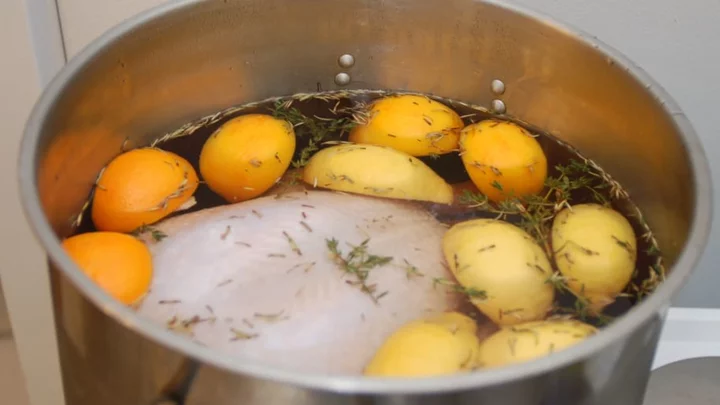Whether this is your first time cooking Thanksgiving dinner or you’re a veteran of prepping the holiday meal, it's a good idea to stay on top of the best ways to deliver the juiciest, most savory turkey.
In recent years, brining a turkey has emerged as a popular method for bringing out the best flavor for Thanksgiving. To learn what you need to know about the art of brining a turkey—including how long you should brine it—keep reading.
What is brining a turkey?
Brining is essentially the same process as marinating—covering meat in a seasoned liquid—and the goal is to absorb moisture and flavor into the bird. The result? An incredibly juicy and succulent turkey. You’ll need a fresh or fully thawed turkey (with the giblet packet removed) and a non-reactive tub or container made of food-grade plastic, stainless steel, or glass that’s big enough to completely fit the bird. You can also use a large plastic brining bag within the container. Keep in mind the container will also need to fit in your fridge during the brining process.
The brine itself is a mix of water, salt, and seasonings, which can include onions, garlic, herbs, and spices. Butterball’s savory brine recipe features soy sauce, dried sage, celery seeds, and more; for a sweeter option, try their recipe for a brown sugar brine.
What are the benefits of brining a turkey?
Many brining fans prefer this method for cooking their turkey because it moistens the meat without much effort and makes preparing the turkey on Thanksgiving easier. Cooks will still need to check on the meat in the oven regularly, use a meat thermometer, and roast it to a safe internal temperature. It might even leave more time for upgrading your Thanksgiving side dishes with new recipes.
How long should you brine a turkey?
According to Butterball, a good rule of thumb is to brine for an hour per pound of turkey. So, if you’re planning a big meal with a 14-pound bird, you’ll need a full 14 hours to brine it. Butterball recommends submerging your turkey the night before you plan to roast it, which will allow enough time for the bird to absorb moisture.
More Tips and Tricks for Brining a Turkey
When making the brine on the stove, make sure the salt completely dissolves. The brine should also be cooled with the addition of ice water before placing the turkey in the container. You don’t want to pour boiling liquid over a fresh turkey, as that will start the cooking process.
Make sure you have room in your fridge before you begin brining; the turkey will likely need to sit in there overnight. The bird should also remain fully submerged in the brine at all times for the juiciest meat.
After you’re done setting up the turkey to brine in the fridge, follow these tips from the USDA to properly sanitize your kitchen. Cross contamination between the raw turkey and other kitchen surfaces can result in food poisoning. No one wants that on Thanksgiving!
With a little planning ahead, you can make a holiday meal that you and your guests will be dreaming about for years to come. And here are some ways to use up those delicious Thanksgiving leftovers.
A version of this story originally ran in 2021; it has been updated for 2023.
This article was originally published on www.mentalfloss.com as Here’s How Long to Brine Your Thanksgiving Turkey.









